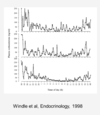Hypothalamic-pituitary-adrenal axis: clinical aspects Flashcards
1
Q
What is shown in the image?

A
Hypothalamic-pituitary axis
2
Q
Hypothalamic-pituitary-adrenal axis
- Releasing factors are … and to a lesser extent …
- Trophic hormone is … (from pituitary)
- Adrenal gland principal hormone is …
- … feedback of cortisol at both the pituitary and hypothalamic levels
A
- Releasing factors are CRH, AVP to a lesser extent
- Trophic hormone is ACTH
- Adrenal gland principal hormone is cortisol
- negative feedback of cortisol at both the pituitary and hypothalamic levels
3
Q
What kind of circulation does the pituitary have?
A
portal capillary circulation

4
Q
- Label the image (Top left, top right, bottom left, bottom right)
- What scan is it? What plane? … weighted

A
- top left arrow = hypothalamus
- top right arrow = pituitary stalk
- bottom left arrow = optic chiasm
- bottom right arrow = pituitary gland with small adenoma (lower intensity)
- MRI scan, coronal plane, T1 weighted
5
Q
The adrenal cortex produces 3 different types of hormones, which are:
- … e.g …
- … e.g …
- … e.g …
A
- Glucocorticoid e.g cortisol
- Mineralocorticoid e.g aldosterone (regulated by renin-angiotensin-aldosterone system)
- Sex steroids e.g androgens
6
Q
In the blood, 90% of cortisol is bound to cortisol binding … (CBG)
A
- 90% is bound to cortisol binding globulin (CBG)
7
Q
Receptors - hypothalamic-pituitary-adrenal axis
- intracellular … and …. receptors
A
- intracellular glucocorticoid and mineralocorticoid receptors (GR & MR)
8
Q
Enzymes - hypothalamic-pituitary-adrenal axis
- 11-B-hydroxy… de… (11-B-HSD)
A
- 11-B-hydroxysteroid dehydrogenase (11-B-HSD)
9
Q
What is shown in the image?

A
Structure of steroid hormones
10
Q
Effects of glucocorticoids
- maintenance of … during times of … (give examples)
- anti-…
- energy balance / … (increase/maintain normal …)
- formation of … and …
- regulation of … …
- cognitive …, …, conditioning
A
- maintenance of homeostasis during times of stress (give examples)
- anti-inflammatory
- energy balance / metabolism (increase/maintain normal glucose)
- formation of bone and cartilage
- regulation of blood pressure
- cognitive function, memory, conditioning
11
Q
Circadian rhythms
Cortisol levels:
- rise during the …
- peak prior to …
- fall during …
- low in the …

A
- rise during the early morning
- peak prior to awakening
- fall during day
- low in the evening
12
Q
Ultradian rhythm
‘…’ of hormone release
A
- pulsatility of hormone release
- only when you average these do you get the circadian rhythm

13
Q
Ultradian rhythm - rats
- sponatenous … of varying amplitude
- amplitude decreases in the … trough

A
- sponatenous pulses of varying amplitude
- amplitude decreases in the circadian trough
14
Q
Ultradian rhythm - humans
- Hard to distinguish the … response

A
- Hard to distinguish the stress response
15
Q
What is shown in the image?

A
- Renin-angiotensin-aldosterone system
16
Q
Circulating Androgens
- include … and Andro… produced by the adrenal glands in both men and women
A
- DHEAS & Androstenedione

17
Q
- Cortisol crosses the cell membrane and links to the … receptor
- translocates into the … and binds there with …
- causes gene …
A
- Cortisol crosses the cell membrane and links to the glucocorticoid receptor
- translocates into the nucleus and binds there with coactivators
- causes gene transcription

18
Q
Enzymes - hypothalamic-pituitary-axis
- In vitro, the ‘…corticoid receptor’ has the same affinity for … and aldosterone
- … is conferred by a ‘pre-receptor’ mechanism
- 11-B-HSD-2 in the kidney inactivates …, enabling aldosterone to bind the … receptor
A
- In vitro, the ‘mineralocorticoid receptor’ has the same affinity for cortisol and aldosterone
- Specificity is conferred by a ‘pre-receptor’ mechanism
- 11-B-HSD-2 in the kidney inactivates cortisol, enabling aldosterone to bind the MR









